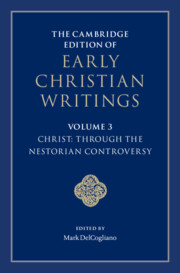Book contents
- The Cambridge Edition of Early Christian Writings
- The Cambridge Edition of Early Christian Writings
- The Cambridge Edition of Early Christian Writings
- Copyright page
- Contents
- Notes on Contributors
- Acknowledgments
- Note on the Texts and Translations
- Abbreviations
- Series Introduction
- Introduction
- Part I The Beginnings of Christology
- Part II Developing Christological Traditions
- 13 Tertullian, Apology 21
- 14 Tertullian, On the Flesh of Christ 1–16 and 24–25
- 15 Tertullian, Against Praxeas 1–4 and 27–30
- 16 Origen, On First Principles 2.6
- 17 Paul of Samosata, Selected Fragments
- 18 Aphrahat, Demonstration 17: On the Son
- 19 Hilary of Poitiers, On the Trinity 9.1–14
- 20 Ephrem the Syrian, Hymns on Faith 4, 10, 24, 31, 36, 51, 54, 77, 78, and 79
- Part III Traditions of Pro-Nicene Christology
- Part IV Controversy over Nestorius
- Suggestions for Further Reading
- Scriptural Index
14 - Tertullian, On the Flesh of Christ 1–16 and 24–25
from Part II - Developing Christological Traditions
Published online by Cambridge University Press: 05 February 2022
- The Cambridge Edition of Early Christian Writings
- The Cambridge Edition of Early Christian Writings
- The Cambridge Edition of Early Christian Writings
- Copyright page
- Contents
- Notes on Contributors
- Acknowledgments
- Note on the Texts and Translations
- Abbreviations
- Series Introduction
- Introduction
- Part I The Beginnings of Christology
- Part II Developing Christological Traditions
- 13 Tertullian, Apology 21
- 14 Tertullian, On the Flesh of Christ 1–16 and 24–25
- 15 Tertullian, Against Praxeas 1–4 and 27–30
- 16 Origen, On First Principles 2.6
- 17 Paul of Samosata, Selected Fragments
- 18 Aphrahat, Demonstration 17: On the Son
- 19 Hilary of Poitiers, On the Trinity 9.1–14
- 20 Ephrem the Syrian, Hymns on Faith 4, 10, 24, 31, 36, 51, 54, 77, 78, and 79
- Part III Traditions of Pro-Nicene Christology
- Part IV Controversy over Nestorius
- Suggestions for Further Reading
- Scriptural Index
Summary
Tertullian’s On the Flesh of Christ offers a defense of the reality of Christ’s human body and the sufferings that he experienced during his time on earth. The work, written around 206, roughly in the middle of Tertullian’s literary career, was directed against alternative views prevailing among some Christian groups concerning the body of Christ. The Christians who held these views are now called docetists. They believed that Christ only seemed to have a human body, and that his sufferings and death were consequently not real. Tertullian’s attack on the docetic perspective targets three influential figures of the second century who had questioned the reality of Christ’s body in different ways. The first of these is Marcion, treated in chapters 2–5, who denied the reality of Christ’s birth and flesh. Second is Marcion’s disciple Apelles, treated in chapters 6–9, who believed that Christ did have flesh during his time on earth, but that he had not really been born. Finally, in chapters 11–16, Tertullian addresses the views of Valentinus and his followers, who granted the reality of Christ’s birth and body, but suggested that his flesh was not human.
- Type
- Chapter
- Information
- The Cambridge Edition of Early Christian Writings , pp. 144 - 172Publisher: Cambridge University PressPrint publication year: 2022



